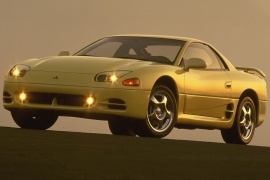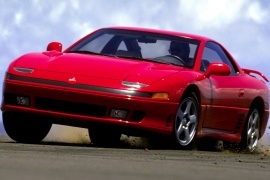MITSUBISHI 3000 GT Models/Series Timeline, Specifications & Photos
First production year: 1990
Engines: Gasoline
Body style: Coupé (two-door)
Mitsubishi updated the 3000GT in 1993 for the 1994 model year, dropping some of its cool factors but adding a few new features.
At the beginning of the '90s, there was a drop in the worldwide economy, and some carmakers felt that on their budgets. Mitsubishi desperately tried to tell people about its models' qualities, but it wasn't very convincing. Despite having a few very good vehicles, such as the 3000 GT pictured here, the sales stalled and eventually led to the model's dismissal seven years later.
The 3000GT was a Grand-Touring vehicle in Mitsubishi's idea, and it wasn't far from reality either. Its look with a long hood and short cabin ended with a wide, sloped rear windscreen was already famous in the mid-'90s. But the most significant change was at the front, where carmaker replaced the pop-up headlights with fixed ones that looked like two spots on each side. In addition, a short but wide fixed wing adorned the tailgate at the back, while the four exhausts under the bumper completed the car's sporty image.
Inside, the coupe featured a sporty but cramped interior. The two-sport bucket seats were suitable for most people, but there was no room for anything else. The carmaker placed the gear stick on the center console, and the center stack housed the controls for the HVAC and audio systems. But the button for the active aero system was gone since it was no longer available.
The Japanese automaker improved the twin-turbo V6 engine along with the facelifted version. While it kept the same 3.0-liter displacement, it provided 20 additional ponies, which were sent to all corners via a six-speed manual or a four-speed automatic. The five-speed manual was ditched.
Mitsubishi updated the 3000 GT four years after the model's introduction, dropping some of its cool factors but adding other new features.
At the beginning of the '90s, there was a drop in the worldwide economy, and some carmakers felt that on their budgets. Mitsubishi desperately tried to tell people about its models' qualities, but it wasn't very convincing. Despite having a few very good vehicles, such as the 3000 GT pictured here, the sales stalled and, eventually, led to the model's dismissal seven years later.
The 3000 GT was a GT vehicle in Mitsubishi's idea, and it wasn't far from reality either. Its look with a long hood and short cabin ended with a wide, sloped rear windscreen was already famous in the mid-'90s. But the biggest change was at the front, where Mitsubishi replaced the pop-up headlights with fixed ones that looked like two spots on each side. In addition, a short but wide fixed wing adorned the tailgate at the back, while the four exhausts under the bumper completed the car's sporty image.
Inside, the 3000 GT featured a sporty but cramped interior. True, the two-sport bucket seats were great for most people, but there was no room for anything else. The carmaker placed the gear stick on the center console, and the center stack hosted the controls for the HVAC and audio systems. But the button for the active aero system was gone since it was no longer available.
Under the hood, Mitsubishi squeezed 20 more horses from the same 3.0-liter twin-turbo V6 engine. Unlike the non-facelifted version, the 1994 model came with a standard six-speed manual. Unfortunately, the car's biggest problem was the weight, which was too big for a sports car.
The 1990 Mitsubishi 3000 GT it was sort of a Grantourismo Japanese car. In order to sell them in the U.S., the Mitsubishi had to cut a deal with Chrysler Corp. So, Chrysler made some exterior modifications and sold it as a Dodge Stealth. But the Mitsubishi was the real deal. And yes. Both had pop-up headlights.
The long, flat, hood, the small cabin, and the big, rear window were part of the Japanese styling. The Acura/Honda NSX had one, but it has the engine in the rear. On the sides, there were some air-scoops in front of the rear wheels but it is hard to understand why. And it had wheels up to 18" which, for 1990, were huge! Imagine that in the same era Mitsubishi Galant had 15" wheels.
Inside, there is a luxurious interior with leather seats and standard manual transmission. Strangely, it has rear seats but those were small even for a bichon. The car featured an interesting audio system that had a CD, a tape player, and a radio.
It had only 3.0-liter V6 engines. But there were three different versions: with 2 valves per cylinder, 4-valves per cylinder and then a 4-valves per cylinder and twin-turbo. The car had either FWD for the lower power versions or AWD for top versions. Its major flaw was the weight. The top VR4 version was almost 1760 kg (3880 lbs).
The 1990 Mitsubishi 3000 GT it was sort of a Grantourismo Japanese car.
In order to sell them in the U.S., the Mitsubishi had to cut a deal with Chrysler Corp. So, Chrysler made some exterior modifications and sold it as a Dodge Stealth. But the Mitsubishi was the real deal. And yes. Both had pop-up headlights.
The long, flat, hood, the small cabin, and the big, rear window were part of the Japanese styling. The Acura/Honda NSX had one, but it has the engine in the rear. On the sides, there were some air-scoops in front of the rear wheels but it is hard to understand why. And it had wheels up to 18" which, for 1990, were huge! Imagine that in the same era Mitsubishi Galant had 15" wheels.
Inside, there is a luxurious interior with leather seats and standard manual transmission. Strangely, it has rear seats but those were small even for a bichon. The car featured an interesting audio system that had a CD, a tape player, and a radio.
It had only 3.0-liter V6 engines. But there were three different versions: with 2 valves per cylinder, 4-valves per cylinder and then a 4-valves per cylinder and twin-turbo. The car had either FWD for the lower power versions or AWD for top versions. Its major flaw was the weight. The top VR4 version was almost 1760 kg (3880 lbs).

